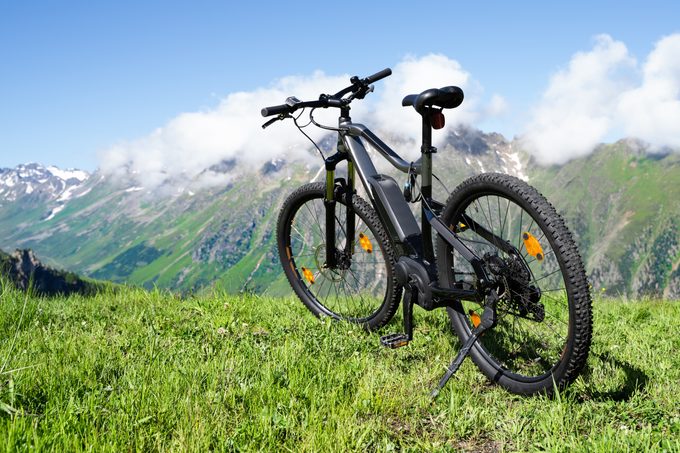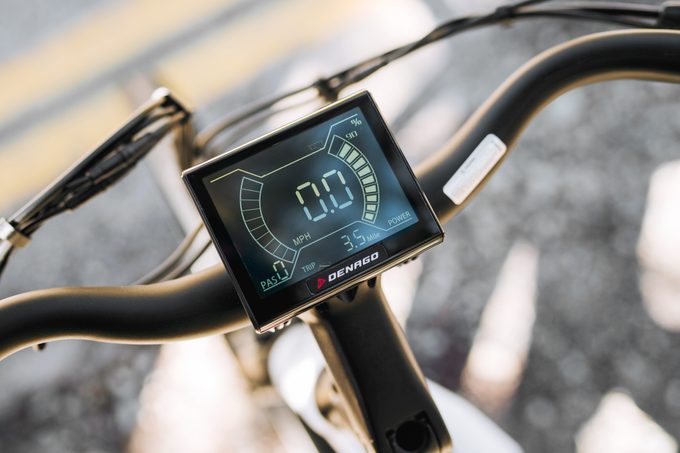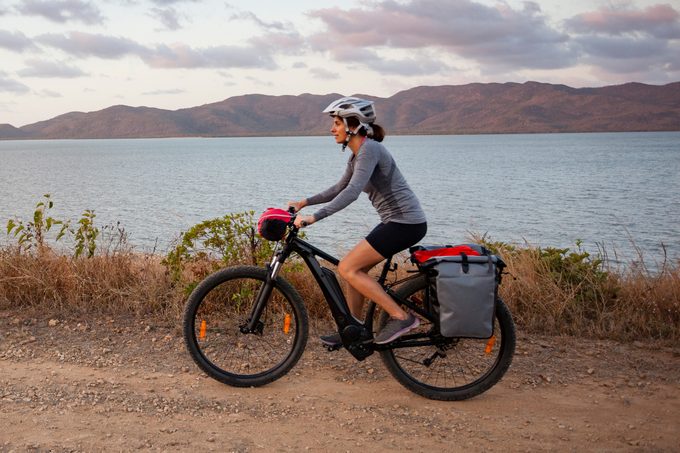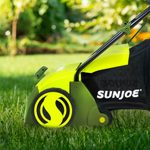How To Choose The Right Electric Bike
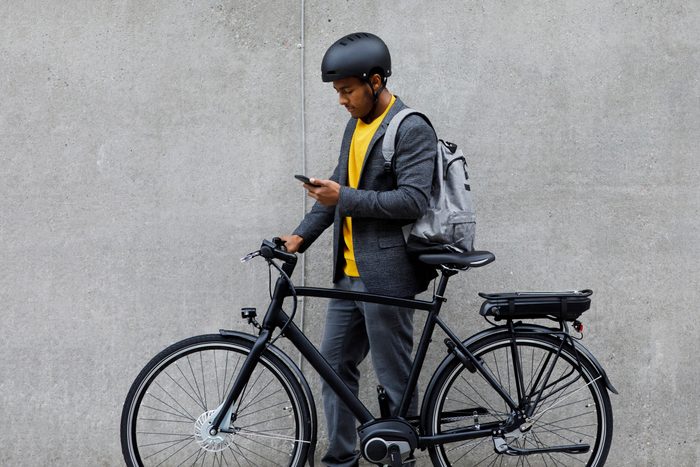
From batteries to bike lanes, here's what you might not have thought about when considering buying an e-bike.
Our editors and experts handpick every product we feature. We may earn a commission from your purchases.
My first exposure to an electric bicycle (aka an e-bike) was on a 20-mile ride with my dad. He rented one while I rode my self-powered mountain bike. When I finally reached our destination, red in the face and weak in the knees, I found him casually lounging on the patio with a cocktail, wondering what took me so long.
I still like my regular bike, but now I’m also hooked on e-bikes. They’re great for commutes, errands and longer jaunts. Recently California’s bicycle coalition, CalBike, collected stories from people about why they ride e-bikes. The stories range from riding in places where it’s too hot to bicycle, to a handyman who hauls lumber and tools on his.
Choosing your first e-bike can be a daunting task. If you’re e-bike curious, here are some things to consider before taking the plunge.
On This Page
What Is an E-Bike?
An e-bike is a bicycle with a small electric motor to help you go farther with less effort.
Unlike a motorcycle, e-bikes don’t propel you on their own. They still have pedals, but the motor adds significant power to your effort, especially when facing obstacles like hills and headwinds. Some also have throttles, which mitigate the need to pedal at all.
“Electric bikes pedal and handle just like a regular bicycle,” says Ash Lovell, the electric bicycle policy and campaign director for the nonprofit People For Bikes. “By and large, an electric bike will use the same parts, too.”
How Long Have E-Bikes Been Around?
In a small capacity since at least the 1890s. But their popularity and availability took off in the 2000s when Yamaha and Panasonic began worldwide mass production.
In 2021, more than 500,000 e-bikes were sold in the U.S. By 2030, the global e-bike market is expected to more than double. Health and climate consciousness contributes to their popularity.
“E-bikes do not generate any polluting exhaust when you ride them, so they are more environmentally friendly,” says Ted Li of Velotric Bike. And pedaling, he adds, can improve cardiovascular health.
How Does an E-Bike Work?
All e-bikes feature a pedal assist option for an extra boost. Some also come with a throttle. Many allow you to turn off the motor so you can ride it like a classic bike.
“A good e-bike rides like the best bicycle you’ve ever ridden and makes you feel like you have superpowers,” says Brett Thurber, founder of The New Wheel, an e-bike store in San Francisco.
“You set a power level and then ride as you would a normal bike. The system senses your effort through a series of sophisticated sensors, and the motor seamlessly adds additional power in proportion to your activity.”
Almost all e-bikes are powered by lithium batteries that can be charged with a standard 110-volt wall outlet. Some have removable batteries. “The cost of electricity to charge an electric bike is minimal, just pennies per mile,” says Kevin Claxton, interim executive director at CalBike.
Types of E-Bikes
“There are just about as many types of electric bicycles as there are traditional bicycles,” says Lovell. Some include cargo bikes, speedy commuting bikes, folding bikes, beach cruisers and fat-tire mountain bikes.
E-bikes come in three classes, based on your energy level and commute:
Class 1
These offer pedal-assist only, with no throttle. The motor assists to a maximum speed of 20 mph, although it will go faster than if you pedal hard or go downhill. These are generally considered identical to a normal bicycle under the law, except on some off-road trails.
Class 2
These come with a throttle that can accelerate the bike up to 20 mph without pedaling. Depending on where you live, there might be more restrictions on where and how you can use Class 2 e-bikes. “Some people like the throttle option because they can keep going if they’re too tired to pedal,” says Claxton.
Class 3
These feature pedal-assist up to 28 mph and usually must be ridden in on-street bike lanes or routes, not multi-use paths. They may have a throttle that works to 20 mph. “A Class 3 bike might be useful if you need to mix with traffic on streets with no bike lanes because you can ride closer to the speed of traffic,” says Claxton.
Regardless of class, e-bike motors are federally limited to 750 watts. Traffic, age restrictions and other laws vary, so check your local regulations.
Thurber also offers this advice: “If your typical ride is five miles or less, consider a standard Class 1 e-bike. If you’re planning to cover further distances on a regular basis, consider a Class 3 to get there quicker and easier.
“Years of experience have taught us that the most important thing is finding the right e-bike for each rider: One that you feel comfortable, safe, and strong riding. The right bike will mean that you will use it more often.”
E-Bike Features
Buying an e-bike can take a lot of research. If you’re lucky and have an e-bike dealer near you, test riding can make your decision easier.
“When you’re buying an e-bike, try to have a clear sense of how you intend to use it, which will tell you whether you should get a standard bike, folding bike, cargo bike, etc.,” says Claxton. “In other respects, e-bikes are simply bikes, and choosing one and riding it is the same as buying any other bike.”
If you’re in the market, here are some of the most important features to consider:
Pedal assist and controller
The controller determines how the electric pedal assistance on your e-bike will function. Generally located on the handlebar, it lets you set a power level from one to four, with four amplifying your pedal power by four times your input. There are two-main types of pedal assist: pedal-activated and throttle-based.
“A good pedal-assist system measures how hard you are pressing on the pedals, your speed, and the cadence of your pedaling to deliver smooth pedal assistance,” says Thurber.
“There are also less sophisticated e-bikes that add assistance through the use of a hand throttle or a sensor that just knows if your feet are moving or not. These often feel jerky and can be difficult to control or to use in challenging environments, such as hills or shared-use infrastructure.”
Motor placement
There are two kinds of motors. Hub motors propel from the front or rear wheel, offering quick acceleration but less range efficiency. Mid-motors power the crankset (gears) and give a better weight-to-performance ratio, but are usually more expensive.
“Hub bikes and Class 2 bikes with throttles can get you to work or school sweat-free, and most people like them for instant power,” says Joe Werwie, head of product for Bike.com. “But they tend to use more of the battery. Some riders like mid-motors more, as it’s a gradual assist and feels more like riding a normal bike.”
Motor power
E-bike motors come in power ratings from 200 watts to 1,000 watts or more, but the legal limit in the U.S. is 750 watts. Most mid-motors are rated around 250 watts. Hub motors are higher.
Battery
Lithium-ion batteries are largely maintenance free, but it’s worth looking into the quality of the battery. You may be bringing them into your house, as well as relying on them to not leave you stranded.
High-quality batteries typically come with a two-year warranty and are increasingly UL certified. Some bike manufacturers sell spare batteries so you can carry an extra one if you go out of range. They should last longer than two years and can be recycled at an electronics recycle site.
Runtime, power and range
Manufacturers state each model’s expected range, usually 40 miles or more. The accuracy of that depends on many factors, including the type of motor, size of battery, rider’s weight, terrain and level of assist you’re using.
“Check the range before you buy and make sure you can get where you need to go each day on a single charge,” says Claxton. “Also, different motors have different assist levels, so make sure you get one that has the power [on the low or high end] that you need.”
Quality of components
If you can afford an e-bike with name-brand components like Shimano, Bosch and others, it will likely last longer and deliver better performance. “There are a lot of low-quality options out there that best-case scenario don’t work well and can be frustrating to service, and worst-case scenario are unsafe,” says Thurber.
Warranty and customer support
Unlike bicycles, some e-bikes don’t come with much of either. Ask the dealer, whether a local store or an online vendor, what the local service and support options are. Research whether the brand has good reviews, seems reputable and stocks replacement parts. A two-year warranty is a good sign as well.
Weight
E-bikes can be upwards of 70 pounds, so check the weight. Look for a lighter model if you have to carry it upstairs or heft it onto a bus or car bike rack.
Price
E-bikes range from around $1,000 to many thousands, with a decent entry level one on the lower end. Increasingly, cities and states are offering rebates and other incentives to put e-bikes within financial reach for more people. Here’s a guide from CalBike, which includes incentives in other states and municipalities.
One way to save money is to convert your standard bike to an e-bike. Here’s more on how to DIY your existing bike into an e-bike using a kit.
Comfort
Asses the saddle (seat), handlebars, grips and tires. Find a bike that fits you and your riding style. “For example, a mountain bike has a more aggressive riding position than a city bike, so may not be as comfortable if you’re just riding on paved roads and some crushed gravel trails,” says Werwie.
Is An E-Bike Right for Me?
“When deciding whether you’d like to purchase an electric bicycle, you should consider how comfortable you are riding a traditional bike,” says Lovell. Then also ask yourself:
- What are the e-bike laws, restrictions and registration requirements in your area? Some states consider e-bikes the same as mopeds and scooters, and some require helmets for riders under a certain age.
- Do you have accessible, safe bike lanes or paths that allow e-bikes?
- Will an e-bike get you to work or the store on a single charge?
- How prevalent is e-bike theft in your area, and do you have a safe place to park it and store it? Werwie recommends this lock. Make sure to secure the frame and pass the cable through both wheels.
Also purchase a good helmet and wear proper safety gear, like close-toed shoes and a safety vest when in traffic. And if you’re new to biking, learn safe riding and etiquette.
“The right electric bike will replace more car trips than you can imagine,” says Thurber. “If your errand is less than five miles one way, you will likely arrive in the same time it would take you to drive and park.”

